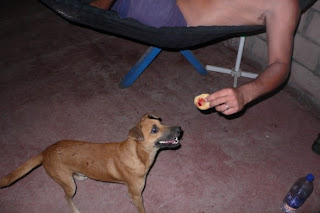I was admittedly a novice at Central American surf beach camping.
Anyone fortunate enough to travel through Latin America has observed careless tourists hemorraging money as they go, drinking too much, and taking little notice of their possessions. As far as this goes, if you can't take the care to safeguard your stuff, you don't deserve to have it. Master this fact, and you are on your way to an understanding.
Just the other day here in the 'tucket, I saw some dude out out walking a dog. Kinda. This guy was was typical NY tourist, collar up, pink shorts, parading his Bichon Frise around Quaker street. I could have kicked the thing a good 30 yards (35 if it hadn't been wearing some kind of jacket).
In El Zonte, I had to step over a dead dog in one of the streets. Meanwhile, this douchebag probably dropped more on his dog in a year than an El Salvadorean family sees in a year.
The thing to understand, is that here in the states we mostly safeguard our dogs. Down there, a dog is a tool with which to safeguard one's possessions.
____________________________________________________________________
How to safeguard one's possessions when beach camping in Latin America.
1) Find a good dog.
It seems a matter of fact that there will be a dozen or so dogs around whatever beach you are camping. They will size you up. These are survivors, but will likely die in a week without you feeding them. The goal is to start a terrible dogfight near your camp. Wait until you have gotten the pack's interest. Throw a couple of tortillas (10 for a quarter) onto the beach. The strongest couple of dogs will win out. Remember what they look like. If one has a louder bark than the other - winner!
could eat his wounded leg.
Often times there will be a family around from you you are renting beach space, hammocks, or living space. In this case, you will inevitably be courting their dogs.
2) Feed the dog a big pile of food.
When you have found a good dog (dominant, good bark), lure it into camp with a tortilla (or day old cookie (a nickel at the bakery). Then leave it 3 more tortillas under your hammocks.
3) Go a short way away.
Take a short walk or surf. 30 minutes to an hour. See if the dog is still there when you get back. TIP: Tie or hang your stuff off the ground or the dog will piss on it.
4) Feed the dog more food.
If the dog is still there, he obviously sees you as a sucker. He will hang out all day for the prospect of a meal. His bark will at least draw attention to a potential camp thief. This is the best you can hope for. Before you leave for dinner toss another few tortillas under your hammock.
5) Sleep with food in your pocket.
On your return, drop the last tortilla, cookie, chicken bone or whatever under your hammock. Go to bed with a tortilla in your pocket, or rub some chicken grease on your shirt during dinner.
____________________________________________________________________
How to safeguard yourself from dogs in Latin America
To be fair, much of what I have to say here can be gleaned from the good read "The Sex Lives of Cannibals" by J Maarten Troost. But I can vouch for it.
Dogs are the first line of defense there. Shotguns are next. If a dog barks at someone, fine. Bites them, fine. Pulls a limb from a bandito - that might actually earn it dinner. These dogs are tough, and aggression is rewarded. Don't feel that you have any recourse with the owner. The only association that exists between most locals and their dogs is the sporadic feeding of chicken bones.
So, don't be a pansy. Expect packs of dogs. Fortunately, rocks are plentiful.
In El Salvador, rocks came in two sizes: distractors and yelpers. Distractors are quarter sized, and go in your left hip pocket (assuming right hand dominance). Yelpers are ping pong ball to racquetball sized, and go in your right hand pocket. You might need them quickly.
When you first get rushed, often times you can keep on walking and toss a few distractors over their heads. Aim isn't important. That's why you can fling with your left hand. Just get them interested in some noise opposite the direction you are traveling. Works best for dogs around houses.
Sometimes though, ya gotta make em yelp. Wing a yelper rock with feeling at the closest dog to you. Odds are he is the dominant one, and the others will follow his lead. Even if you miss, Latin American dogs understand what a good rock throw is all about, and will back off a bit. If it is too dark to see clearly, skip a yelper in front of a dog. This will buy you some space, and opportunity to throw a few empty handed fakes to conserve your supply.










